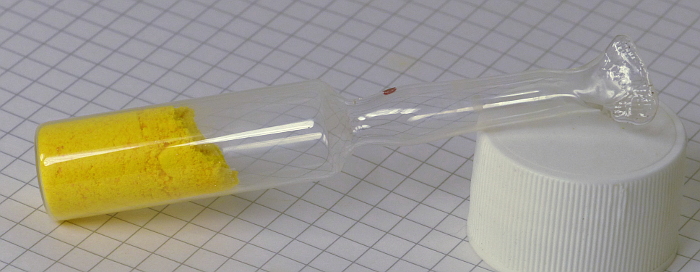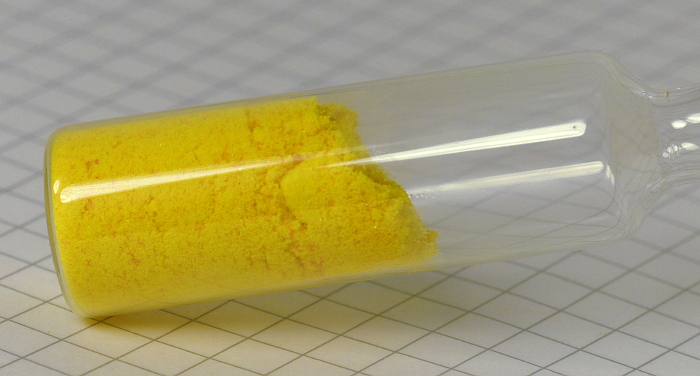Phosphorus pentabromide - PBr5

This is a sample of 3 grams of solid phosphorus pentabromide, sealed in an ampoule, which protects it from moisture. Phosphorus pentabromide is exceedingly moisture sensitive and extremely corrosive. It is one of the strongest brominating agents, which can replace -OH groups from organic molecules by -Br atoms, e.g. it can convert organic acids of structure R-C(O)OH to the acid chlorides R-C(O)Br.
Phosphorus pentabromide is only marginally stable. Even when heated gently, it easily loses bromine, which can be observed as brown/red bromine vapor. In the solid state, phosphorus pentabromide exists as a salt, being PBr4+/Br‒. In the gas phase it does not exist, on gentle heating it completely decomposes to PBr3 and Br2.
When phosphorus pentabromide is added to water, copious amounts of hydrogen bromide are formed and phosphoric acid dissolves in the water. This reaction is very violent.
The picture below shows a more detailed view of the yellow solid in the ampoule.

This compound can be made from phosphorus
tribromide and bromine, by carefully and slowly mixing a solution of
phosphorus tribromide in a suitable non-polar volatile solvent (e.g.
carbon disulfide or carbon tetrachloride) with a solution of bromine in
the same solvent. PBr5 separates from the solvent. In its
solid ionic form it does not dissolve in non-polar solvents. By keeping
the filtered yellow solid under a not too strong vacuum for a while,
the volatile solvent evaporates and dry pure phosphorus pentabromide
remains behind.
Storage of phosphorus pentabromide is
difficult. The only way in which it can be kept around for a longer
time is by ampouling it. Its extreme air-sensitivity, combined with its
extreme corrosiveness, makes storage in ordinary containers nearly
impossible. For these reasons, phosphorus pentabromide remains a lab
curiousity and nothing more than that. There is little practical use
for this compound.